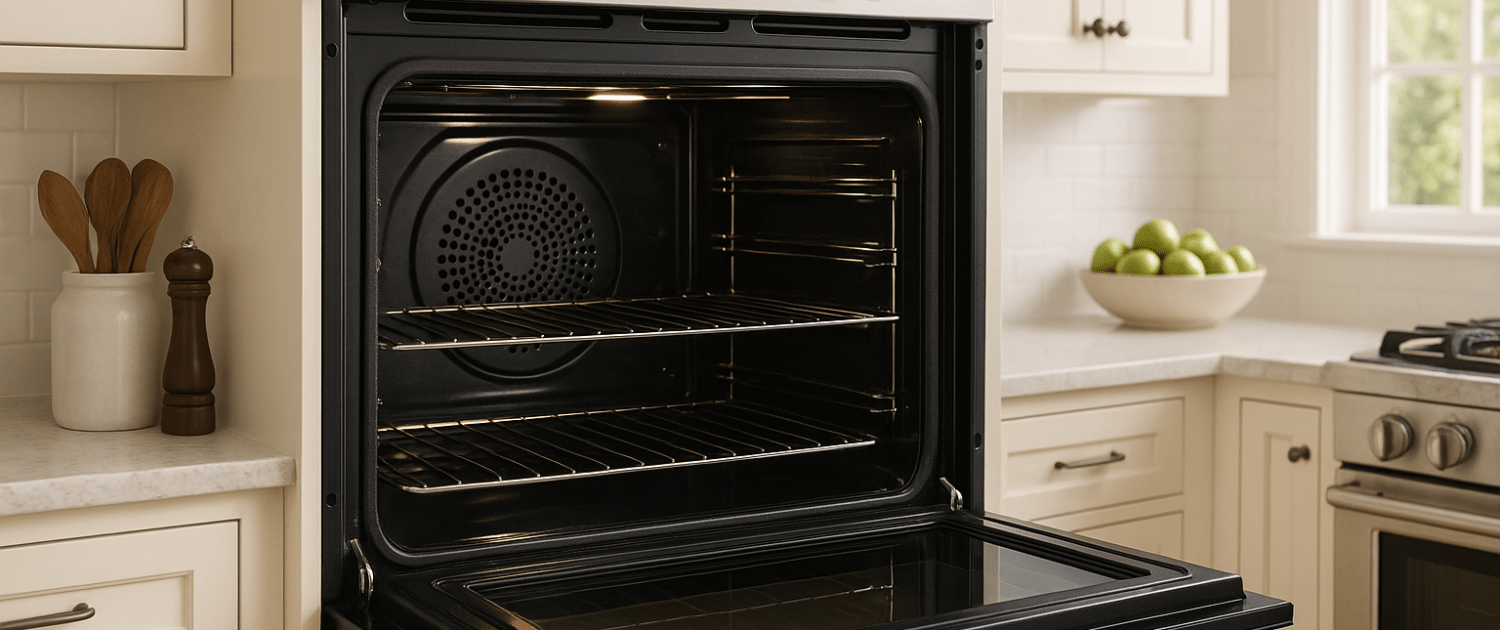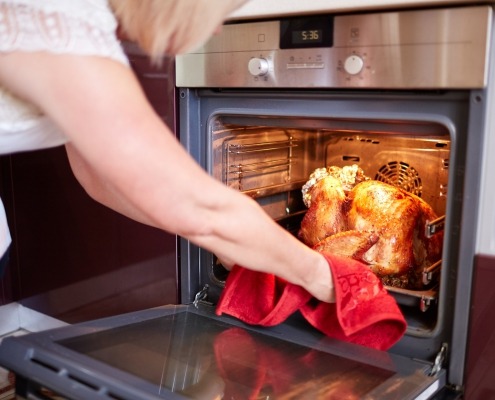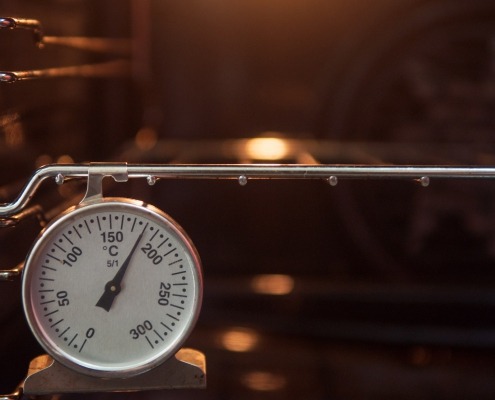How to Master Convection Oven Cooking with Ease
Steven E / Monday May 12, 2025
Thinking about giving your convection oven a try? You’re in the right place. Whether you’re just unboxing your first one or trying to figure out why your cookies bake unevenly, this guide will help you nail the ins and outs of convection cooking. Let’s crank up the fan and make your meals crispier, tastier, and way more efficient.
The information in this article may not apply to your specific appliance model. We recommend consulting your manufacturer’s documentation or contact us with any questions.
What is convection cooking?
A convection oven contains a fan that circulates hot air around the interior of the oven. The fan and exhaust system help to spread heat more efficiently and evenly around food. Models may also have an additional heating element by the fan to help supercharge the hot air flow.
This differs from a standard radiant oven, where heat is generated by elements on the top and bottom of the oven. The air remains relatively still, just surrounding the food. Heat reaches the food through direct radiation from the elements.
In a convection oven, the constant flow of hot air provides faster and more even cooking by transferring heat energy more rapidly to the surface of the food. The accelerated heat transfer makes convection ovens about 25-30% more efficient than conventional ovens. This allows you to cook meals faster and at lower temperatures.
Advantages of convection
There are several key advantages that convection ovens offer compared to standard ovens:
- The circulating air transfers heat faster, meaning you can cook food up to 25-30% faster. This saves you time in the kitchen.
- Since the hot air cooks food more efficiently, you can use lower oven temperatures to achieve the same results. This can aid in moisture retention.
- The constant air flow helps produce better caramelization and crispy textures on the exterior of foods.
- No more rotating pans halfway through cooking! The circulating air eliminates cold spots and uneven cooking.
- Convection allows you to use multiple racks with consistent results, unlike a standard oven where you need to rotate pans.
- For some foods like roasts and baked goods, convection creates a gentle environment that keeps moisture locked in.
- The constant airflow prevents excessive browning and overcooking on the outer edges of foods.
- Since food cooks faster, convection ovens actually use less energy than conventional ovens to cook meals. This can help lower electricity bills!
Best foods to cook in a convection oven
Certain types of cooking and baking see the biggest benefits from convection ovens. Here are the best uses for the convection setting:
Meat roasts
Tender, juicy roasts with browned, crispy exteriors are easy to accomplish in a convection oven. The circulating air will brown and crisp the exterior while locking in moisture for succulent results.
Whole chickens and turkeys
Say goodbye to rotating pans halfway through cooking! The constant air flow allows poultry to cook perfectly and evenly from all sides. Convection ovens yield incredibly moist, beautifully browned birds.
Pizza
Take your homemade pizza to the next level with convection cooking. The hot air flow bakes the crust quickly for a crispy exterior, melts the cheese evenly, and prevents sogginess.
Cookies and pastries
Bake cookies, biscuits, scones, and other treats in a convection oven for professional-quality consistency. The increased moisture retention gives pastries a lift.
Breads
Artisan breads come out with the perfect crusty exterior and soft, chewy interior when baked in a convection oven. Say bye to dense loaves!
Casseroles
Covered casseroles cook faster in convection ovens while retaining all their bubbly, saucy goodness on the inside.
Roasted vegetables
For the best crispy roasted potatoes, Brussels sprouts, and more, use the convection setting. The dry heat helps caramelize veggies beautifully.
Fried foods
The circulating air mimics deep frying, allowing you to make crispy fried chicken, potato wedges, and more in the convection oven. A healthier cooking method!
Foods to avoid in a convection oven
While a convection oven excels at many cooking tasks, the intense airflow is not ideal for everything. Here are some instances where you’ll want to avoid the convection setting:
- Delicate cakes and breads – The airflow can prevent the batter from rising properly, creating dense results.
- Soufflés and meringues – These airy items need gentle, still heat to rise and set. Convection will cause them to fall.
- Custards like crème brûlée and flan – The fanned air can overcook custards, curdling the eggs.
- Other delicate baked goods like macarons – They require precise, static heat to form their signature “feet.”
For anything that starts from a thick, loose batter or depends on gentle heat to set and rise, stick to conventional oven methods. The still heat allows for more control.
How to use a convection oven
Here are some key tips for using a convection oven successfully:
- Lower the temperature by 25°F from what your recipe states to prevent overcooking in the faster convection environment.
- Invest in an oven thermometer and meat thermometer. Ovens often run hot or cold, so confirming temperatures is essential.
- Set your timer to go off at least 10 minutes sooner than the recipe suggests. Then check the food and continue cooking if needed.
- Shallow sheet pans, rimmed baking sheets, and roasting pans allow maximum airflow around your food.
- Leave space between pans and dishes so air can circulate efficiently.
- Prevent delicate cookies and baked goods from sticking when the convection fan blows on them.
- Mist loaves with water before baking to prevent the crust from getting too dry in the convection environment.
- Secure parchment paper with kitchen objects so it doesn’t blow around when the fan is on.
- Some ovens automatically reduce the temperature when you select the convection function. Check to see if yours does.
Convert standard recipes for convection cooking
To convert traditional recipes for convection ovens, use the following guidelines:
- For baking dense items like meat roasts, casseroles, and pizza, reduce the temperature by 25°F.
- For baking delicate items like cookies, cakes, and breads, reduce the temperature by 50°F.
- Start checking on the food at least 10 minutes sooner than the shortest cooking time recommended. For items taking over an hour, check every 30 minutes.
- Watch carefully at the end and remove the food as soon as it is finished cooking through. Items go from perfect to overdone quickly in convection ovens.
- Make note of convection cook times as you test recipes so you know how much to shorten them the next time you make the dish.
With a bit of experimentation, you’ll determine ideal time and temperature adjustments for your favorite recipes. Maintain detailed records so you can replicate your convection successes.
Convection setting on new oven models
If your current oven does not have the convection feature, you may want to consider upgrading when purchasing new appliances. Here are a few things to keep in mind:
- True convection ovens are ideal, as they include a third heating element by the fan to supercharge airflow. Look for that specification when shopping.
- Expect to pay $100-$300 more for a convection oven compared to a standard model. This is well worth it for the cooking benefits.
- Convection can be added to all fuel types – it is available in gas, electric, and induction ovens. Choose the energy source that best suits your needs.
- High-end brands offer exceptional convection modes. But more budget-friendly models also perform very well.
- Pay attention to CFM ratings (cubic feet per minute), which indicate how powerful the convection fan is. Higher CFMs mean faster, more consistent cooking.
With an understanding of how convection ovens work and the best ways to use them, you can take your cooking to the next level. Mastering convection methods allows you to produce amazing roasts, baked goods, crispy veggies, and more. Implement the tips in this guide and you’ll be excelling at convection cooking in no time!
More information
Though they require a small learning curve, convection ovens allow you to cook food faster and more evenly every time. Now that you understand the mechanics behind convection and have helpful tips for converting recipes, you can start using this setting for all its benefits.
Thanks for reading! If you have any other appliance repair needs or projects, you can find more resources including our DIY blog at AppliancePartsPros.com. There, you can enter your model number to order the exact parts you need. Most orders arrive in two business days.
You can also reach our award-winning customer service team at 1-877-477-7278, chat with a pro on our website and watch thousands of free video tutorials on our YouTube channel.
With nearly a decade of experience in providing top-notch customer service regarding appliance parts and repair, Steven enjoys sharing practical advice, troubleshooting tips, and interesting information to help readers stay informed.





